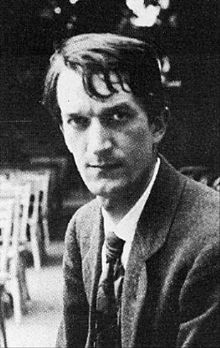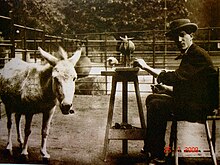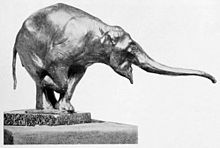Rembrandt Bugatti
Rembrandt Bugatti (born October 16, 1884 in Milan , † January 8, 1916 in Paris ) was an Italian sculptor . He is the younger brother of the automobile designer Ettore Bugatti . His work primarily includes animal sculptures and is considered a very independent artistic position within early modern sculpture . He is one of the main Italian pioneers of Art Deco .
life and work
Rembrandt Bugatti was the third child of the Milan-based furniture designer Carlo Bugatti and his wife Teresa Bugatti, b. Lorioli. According to family tradition, his first name, which refers to the Dutch baroque painter Rembrandt van Rijn , was suggested by his godfather, the Italian sculptor Ercole Rosa . Rembrandt grew up in a highly artistic environment: the painter Giovanni Segantini was his uncle, and sculptors such as Ercole Rosa and Paolo Troubetzkoy, as well as composers, including Ruggero Leoncavallo and Giacomo Puccini , frequented his parents' house . Rembrandt's talent was discovered and promoted early on. First exhibitions in Milan, Turin, Venice and later in Paris caused a sensation and brought the young artist recognition and success. Through his collaboration with the gallery owner and bronze caster Adrien-Aurélien Hébrard in Paris, who also reproduced models by Degas and Rodin , his works in bronze casts of the highest quality found their way into many important collections. The artist's mood darkened under the impact of the First World War . In 1916 he committed suicide in Paris. He was only 31 years old.
As an adolescent, Rembrandt Bugatti had shown such a striking talent for sculpture that he no longer had to attend an art academy. He was only 16 years old when he made his debut with his first sculpture at the spring exhibition in Milan in 1901. Just as early on, Bugatti found a topic that would occupy him for life: animals. At first he mainly modeled cows, but as a young man he discovered exotic animals from all over the world in the zoological gardens of Paris and Antwerp : Anteaters, tapirs and maraboos, yaks, secretary birds and kangaroos are the subject of Bugatti for the first time in European art history Sculpture. He was particularly fond of the big cats, whose power and elegance he immortalized in numerous sculptures.
Rembrandt Bugatti looked long and hard at his models. Then he created almost all of the sculptures in a single step in front of or even in the animal enclosure itself. An extraordinary sense of the right moment allowed the artist to capture the most striking moment of the animal being and thereby create actual portraits. Because it was always about the exact recording of the peculiarities, movements and feelings of his counterpart. Bugatti's work is characterized by great artistic freedom and the mastery of his sculptural means. Through precise observation and profound empathy, he gave his characters a remarkable presence. Bugatti's formal language oscillates between naturalism and expressionism, cubism and futurism, and yet has retained the curiosity and opulence of the Belle Époque .
Paris time
Around 1904 Rembrandt Bugatti moved to Paris with his parents and older sister Deanice with his family. Troubetzkoy put in contact with the gallery owner Adrien-Aurelien Hébrard, who from 1904 onwards regularly showed Bugatti's works in his gallery and organized other exhibitions. With the support of Hébrard, who had his own foundry, Bugatti was now able to regularly produce bronze casts of his sculptures, which were cast using the lost wax process and were characterized by high-quality, dark patinations. Bugatti quickly established itself in Paris. His exhibitions received positive reviews and his gallery owner managed to sell many of his works.

1904 Bugatti created a rearing elephant as signet of his brother's seal. This sculpture became famous many years later: Ettore Bugatti used it as a hood ornament for the Bugatti Type 41 "Royale" , his most ambitious and perhaps most legendary automobile.
1907 was Rembrandt Bugatti's most successful and creative year in artistic terms. In the course of the year, however, he separated from his family and, after receiving an invitation from the local zoological society, moved to Antwerp alone .
Antwerp time
Rembrandt Bugatti settled permanently in Antwerp in the late summer of 1907.
Antwerp was known as an arts center; there was the most important art school in Belgium, the Royal Academy of Fine Arts . The city zoo was of particular importance to Rembrandt Bugatti. He had numerous wild animals that were brought into the country by wild catchers from overseas. Bugatti worked here like a number of other artists in front of the living motifs. During the Antwerp period he made sculptures of baboons, antelopes, leopards and flamingos.
The high point of Bugatti's time in Antwerp was the year 1910. In the early summer of that year he organized his first major solo exhibition at the Royal Zoological Society, which became an artistic success. In the period that followed, Bugatti continued to develop its style. His sculptures became more geometric, structured and angular. With his branch in Antwerp, Bugatti's contact with his family and other artists was increasingly reduced. From 1914 health and financial problems came along; Bugatti may have developed depression around this time.
The First World War and death
At the beginning of the First World War , Rembrandt Bugatti signed up as a volunteer for the Belgian Red Cross. He worked in a hospital that had been set up in the Antwerp Zoo and helped care for the wounded. Due to a lack of food, the zoo management began killing animals. These experiences worsened the artist's condition. At the end of 1914 he traveled to Italy and later to Paris. The collapse of the art market increased Bugatti's financial hardship because he could no longer find buyers for his work during the war. His last works are a tiger trampling a snake and a Christ on the cross, his only sacred work at all.
On January 8, 1916, Rembrandt Bugatti committed suicide with gas in his Paris studio.
Exhibitions
- 1983: The Bugattis . Exhibition with 30 works by Rembrandt Bugatti in the Museum of Art and Industry Hamburg . Curator Heinz Spielmann
- 2014: Rembrandt Bugatti. The sculptor 1884–1916 , Alte Nationalgalerie , Berlin. Catalog.
literature
- Philipp Demandt and Anke Daemgen: Exhibition catalog: Rembrandt Bugatti, The Sculptor 1884-1916 . Hirmer, Munich 2014, ISBN 978-3-7774-2186-5 .
- Edward Horswell: Rembrandt Bugatti, life in sculpture 2004, Sladmore Gallery Editions / Editions de l'Amateur
- Joachim Kurz: Bugatti. The Myth - The Family - The Company 2005
- Veronique Fromanger: Rembrandt Bugatti-Répertoire monographique 2010, Editions de l'Amateur Paris
- Heinz Spielmann : Rembrandt Bugatti . In: The Bugattis. Exhibition catalog of the Museum for Art and Industry Hamburg 1983.
- Fiction
- Edgardo Franzosini: The Animal Gazer. Roman, The Head of Zeus, London 2019
Web links
- www.rembrandtbugatti.info
- Rembrandt Bugatti in Berlin - Exhibition Alte Nationalgalerie 2014
Individual evidence
- ^ Philipp Demandt and Anke Daemgen: Exhibition catalog "Rembrandt Bugatti", Munich 2014.
- ^ Rembrandt Bugatti (1884-1916) . Biography on bronze-shop.com.
- ^ Philipp Demandt and Anke Daemgen: exhibition catalog "Rembrandt Bugatti", Munich 2014, p. 23 ff.
- ^ Spielmann: Rembrandt Bugatti. P. 140.
- ↑ In short: Bugatti. The myth, the family, the company. P. 28.
- ↑ Craig Cheetham: The Encyclopedia of Classic Cars, p. 40.
- ^ Spielmann: Rembrandt Bugatti. P. 142.
- ↑ In short: Bugatti. The myth, the family, the company. P. 34.
- ^ Philipp Demandt and Anke Daemgen: exhibition catalog "Rembrandt Bugatti", Munich 2014, p. 38 ff.
- ↑ A young man goes to the wild animals in FAZ of March 28, 2014, page 13.
- ^ Antilopen in the studio in the Frankfurter Allgemeine Sonntagszeitung on March 30, 2014, page 43.
| personal data | |
|---|---|
| SURNAME | Bugatti, Rembrandt |
| BRIEF DESCRIPTION | Italian sculptor |
| DATE OF BIRTH | October 16, 1884 |
| PLACE OF BIRTH | Milan |
| DATE OF DEATH | January 8, 1916 |
| Place of death | Paris |



